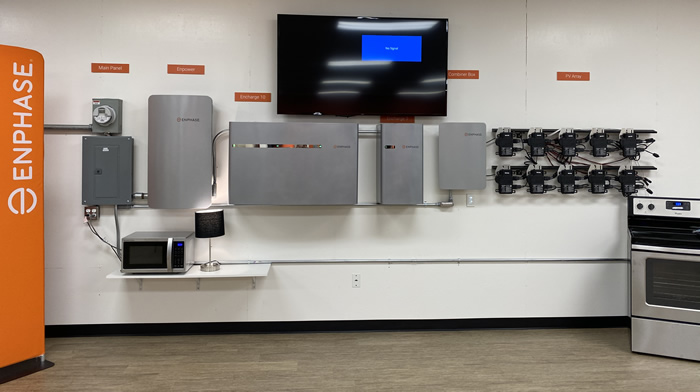Welcome to the
Run on Sun Monthly Newsletter

In this Issue: |
September, 2020
Volume: 11 Issue: 9
Scam Warning - Why Solar is NOT a DIY ProjectIf you spend anytime at all reading information about solar energy on the Internet you will have come across one of those ads: "Do it Yourself Solar!" and on and on. Sounds enticing - after all, who wouldn't like to green up their life while saving money? But the scammers have you squarely in their sights and their do-it-yourself kits are a ripoff of your hard earned money. At a minimum, there are at least three good reasons why solar is not a DIY project: 1) DC isn't AC, 2) Safety, and 3) Utilities. Let's look at each one of these in turn. DC isn't AC - Solar panels produce direct current (DC), just like your car battery. But the energy in your home is alternating current (AC) which reverses polarity 60 times a second. Now a very few of the loads in your home won't care - an incandescent light bulb will burn just fine with either AC or DC. But your air conditioning system won't. Nor will your TV, your computer, your refrigerator, or nearly anything else that you own. All of them are designed to operate on AC and running them on DC will either damage them, or do nothing at all. Yet those are the things that drive your utility bill. A $200, DIY solar panel (assuming for the sake of argument that such a thing can even be built) will do nothing to lower those bills. So right off the bat, the huge $$$ savings promised are just that - a "pie-crust" promise - easily made, easily broken. Safety - Quality solar panels sold in the United States are approved by Underwriters Laboratory (i.e., "UL Approved") for safety. Since even a single solar panel can generate dangerous amounts of electricity, that approval provides peace of mind that the solar panels sitting on your roof will operate safely for the 25 years that you will own them. Can the same be said for a DIY solar panel? What if the unthinkable happens and your DIY solar panel malfunctions and starts a fire. Will your homeowner's insurance cover the loss after they learn that you placed solar panels on your roof that weren't UL approved? Is that a risk you want to take? Utilities - If you are looking to lower your utility costs, you will need to connect your DIY system to the utility grid. Before you can legally do that, your system has to have an inverter that meets not only UL approval but also the IEEE standard to prevent "islanding". The "anti-islanding" feature of a modern inverter is extremely important - here's why. A residential grid-tied solar power system is a small power plant connected remotely from the utility's other power plants. If a power line goes down, the utility will dispatch a crew to repair the break. Before doing so, they will isolate that portion of the grid so that the lines are de-energized, allowing the workers to handle them safely. But wait - they cannot isolate your mini power plant down the street which is acting as a power-generating island all unto itself. That means the downed power line is still hot - and deadly. To prevent such situations, "anti-islanding" technology is built into every grid-tied inverter sold in the U.S. Building such an inverter is definitely not a DIY project, unless you are an electrical engineer. Funny, but those ads never seem to talk about any of this. Sure, we have a vested interest - we are in the business of installing high-quality, safe and reliable solar power systems. But we aren't worried here about losing a few sales. Rather, we are worried about solar getting a bad reputation from hucksters and scammers souring people who were excited about the possibility of going solar, but got mislead and wasted their money and their time. We believe - and have blogged about - the absolute right of consumers to be treated ethically by the solar industry. We will continue to write about risks to that ethical standard, whether from conventional installers doing shoddy work (see here) or from rip-off artists and scammers like these. |
“Will your homeowner's insurance cover the loss after they learn that you placed solar panels on your roof that weren't UL approved…”
Help Us Spread the News!


Power Start - Giving Storage Systems a Boost! Enphase Ensemble Lab in Petaluma When you are turning on your AC or other large household appliances, you probably don’t think about how much current these systems require to start-up. Yet many appliances are going to be pulling anywhere from 2 to 2.5 times their regular running current to complete the start-up process. This large change in amperage is what we call a “surge current”. “Surge current refers to a short-term spike in power demand from a particular appliance to get it started…” For example, when your car battery dies– you have to jump it using another cars battery. “Something similar happens for high load appliances in your home when they are turned on,” suggests Enphase. With the recent fires and grid blackouts– Californians are coming to grips with the pressing need for solar energy backed by smart storage. The current storage systems on the market have struggled to keep up with surge current loads. This makes it nearly impossible for homes to be independent from the grid. Your system may be able to keep your appliances running, but what happens when they stop? According to Enphase, "This inability to handle power-hungry appliances has been a challenge for battery storage systems for years… until now.” Into that void now comes the new Power Start™ by Enphase. This technology is designed to help reliably start every appliance in your home during a blackout. Power Start’s unique algorithm detects when a large appliance is trying to start back up and automatically disperses the same amount energy over a fraction of a second. This technology can be added onto the Encharge 10 battery systems, which have a continuous power rating of 3.84kWs and a surge power rating of 5.76kWs for 10 seconds. You can click this link to find common surge current demands within different appliances. The new Power Start by Enphase is a necessary and vital addition to battery storage systems. This technology will improve reliability and independence from the grid. |
